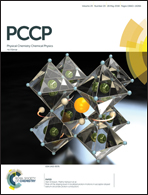Understanding the deformation mechanism and mechanical characteristics of cementitious mineral analogues from first principles and reactive force field molecular dynamics†
Abstract
In this paper, first principles and reactive force field molecular dynamics were utilized to study the mechanical properties of tobermorite 9 Å, tobermorite 11 Å and jennite. These are essential minerals in cement chemistry. The mechanical properties calculated by the first-principle method match well with previous experimental results, pointing to the introduction of vdW dispersion-type forces as able to improve the precision. The calculated elastic constants of the three minerals confirm anisotropic mechanical behavior of the layered structures. The crystals jennite and tobermorite 9 demonstrate stronger mechanical behavior in the ab plane than the interlayer direction due to the presence of stable covalent “dreierketten” silicate chains. For tobermorite 11 Å, the Q3 silicate tetrahedrons bridging the neighboring calcium silicate sheets heal the weak interlayer structure and enhance the c-direction stiffness and cohesive strength. Furthermore, analysis of uniaxial tension by reactive force MD elucidated the chemical and mechanical responses of the atomic structures in loading resistance. The stress–strain relation of the layered mineral tensioned along b direction, showing the “strain hardening” region, where stress continues to increase past the yield stage. The strain hardening and ductility enhancement for the minerals is largely due to the ability of the silicate chains to first de-polymerize into short chains or separate tetrahedrons before the broken Q species re-polymerize to form branched networks and ring structures which are able to resist loading. For all three minerals, protons transfer to oxygen and water, resulting in the formation of Si–OH and Ca–OH groups during the strain hardening stage as Si–O–Si or Si–O–Ca bonds start to break and the calcium atoms and silicate morphology is rearranged. Hydrolysis therefore accelerates structural damage and contributes to weakening of mechanical properties in the interlayer direction. Increased tensile stress level in the tobermorite 11 Å can contribute to a greater extent of water damage.



 Please wait while we load your content...
Please wait while we load your content...